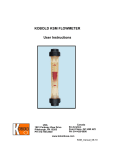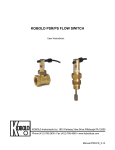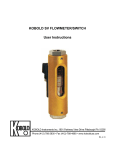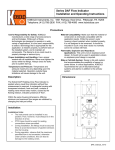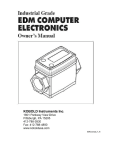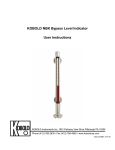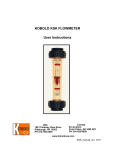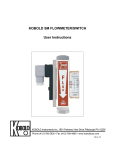Download Manual
Transcript
KOBOLD LPS AIR FLOW MONITOR User Instructions Kobold Instruments Inc. 1801 Parkway View Drive Pittsburgh, PA 15205 412-788-2830 Fax 412-788-4890 KOBOLD Instruments Canada Inc. 9A Aviation Point Claire, QC H9R 4Z2 514-428-8090 Fax 514-428-8899 www.koboldusa.com FM Rev. 04/13 LPS Table of Contents 1.0 General ............................................................................................. 1 2.0 Specifications ................................................................................... 2 3.0 Installation instructions...................................................................... 4 4.0 Operation .......................................................................................... 5 4.1 Adjusting the setpoint .......................................................... 5 4.1.1 Activating the Setpoint on Rising Flow ................ 5 4.1.2 Activating the Setpoint on Falling Flow................ 5 Adjustment of the Setpoint Beyond Factory Limits ......... 5 4.2 5.0 Maintenance ..................................................................................... 6 6.0 Arrival of Damaged Equipment ...................................................... 6 7.0 Need Help With Your LPS ............................................................... 6 List of Diagrams Diagram 2.2 Electrical Connections ................................................... 2 List of Tables Table 2.1 Materials of Construction ...................................................... 2 FM Rev. 04/13 LPS KOBOLD LPS AIR FLOW MONITOR User Instructions CAUTION: 1.0 For safety reasons, please read the cautionary information located at the end of the manual, before attempting installation. General The KOBOLD LPS flow monitor is an air flow activated switch intended for use in situations where a minimum or maximum airflow must be maintained. It is designed to be mounted directly on duct work for use in applications where airtight installation is not necessary. The device operates as follows: 1. Flowing air impacts upon a paddle attached to a lever which has its pivot point in the instrument housing (outside the airflow). This causes the paddle/lever arrangement to pivot about its hinge point. 2. The motion of the paddle/lever is opposed by a spring whose tension is setscrew adjustable. The amount that the lever pivots for a given airflow can, in this fashion, be controlled. 3. Positioned in the path of the paddle/lever is a microswitch. When the lever pivots through a preset angle, the microswitch is activated. 4. Result: Activation of the microswitch can, through use of the set screw/spring arrangement, be chosen to occur at a predetermined airflow rate. FM Rev. 04/13 LPS 2.0 2 Specifications Operating Principle: Spring-resisted paddle Range: 195 - 1575 ft./min. (turn-off) 395 - 1810 ft./min. (turn-on) Pressure: Ambient Maximum Temperature: 185° F (Media & Ambient) Table 2.1 Materials of Construction Paddle: SS Lever: Brass Connection/Mounting Plate: Steel Housing: Base: ABS Cover: Polycarbonate Diagram 2.2 Electrical Connections Switching Voltage: 24 - 250 VAC Switching Current: 8 A Max. (Inductive) 15 A Max. (Resistive) Maximum Power: 2000 VA Switch Action: SPDT Connections: Red: Common Blue: N/C (opens w/flow) White: N/O (closes w/flow) CAUTION: Exceeding any one maximum electrical rating will create a fire hazard. FM Rev. 04/13 3 3.0 LPS Installation Instructions CAUTION: For safety reasons, please read the cautionary information located at the end of the manual, before attempting installation. The LPS flow monitor is designed for direct installation onto the flat surfaces of air handling duct work. The orientation of the instrument is unimportant. However, the airflow direction must be in the direction indicated by the arrow on the instrument base. The instrument is held in place by four (4) sheet metal screws (not supplied). For installation, after selecting an appropriate mounting location with sufficient clearance for both the paddle and cover housing, trace around the inside perimeter of the mounting gasket with a pencil or marker. Mark the mounting screw holes and then drill appropriately sized pilot holes for the mounting screws (self-drilling screws may also be used). Neatly trim the marked opening in a workmanlike manner to allow for sufficient paddle and lever clearance. Note: To avoid damage in transit, your LPS flow switch has been disassembled. It temporarily consists of three parts. These parts are: 1) main body, 2) gasket, 3) paddle. The gasket is to be used during installation to form a vibration free seal with the duct metal. The paddle must be reinstalled to the main body as follows: 1. Remove screw and lockwasher from lower part of paddle arm. 2. Align holes in paddle with screw hole and positioning pin in paddle arm. 3. Replace screw and lock washer. 4. To check your work, compare with LPS picture on cover of this manual. 5. Congratulations! You are now a veteran LPS paddle installer. Use the supplied gasket to seal off the area between the LPS and the supply duct. Install the assembled flow switch into the duct and secure the mounting screws. Connect to the internal switch by removing housing, leading cable through inlet and connecting according to Diagram 2.2. FM Rev. 04/13 LPS 4.0 4 Operation After installation, the switch point may be adjusted. Note that the switch point is dependent upon the mounting orientation of the LPS. This is due to the weight of the paddle acting with or against the paddle spring. If you have reoriented your LPS, it will be necessary to reset the switch point. 4.1 Adjusting the Setpoint Diagram 2.2 shows the placement of the setpoint adjustment screw. Turning this screw clockwise will increase the flow rate required to activate the switch. 4.1.1 Activating the Setpoint on Rising Flow To adjust the microswitch to trigger on rising flow, do as follows: 1. Establish desired setpoint flow rate in the system. 2. Turn setpoint screw fully clockwise. 3. Slowly turn setpoint screw counterclockwise until microswitch activates 4. Replace housing cover. 4.1.2 Activating the Setpoint on Falling Flow To adjust the microswitch to trigger on falling flow, do as follows: 1. Establish desired setpoint flow rate in the system. 2. Turn the setpoint screw fully counterclockwise. 3. Slowly turn setpoint screw clockwise until the microswitch activates. 4. Replace housing cover. 4.2 Adjustment of the Setpoint Beyond Factory Limits Since the LPS is activated by the force of the moving air, it is possible to increase the maximum setpoint values by shortening the paddle. If you choose to do this, we recommend that you trim the paddle a little at a time to avoid overcompensation. FM Rev. 04/13 5 5.0 LPS Maintenance The simple design of the LPS assures an almost maintenance free instrument. The only possible maintenance area is the lever hinge of the LPS. If operating in a humid environment, we suggest that the lever hinge be checked occasionally to assure free movement. 6.0 Arrival of Damaged Equipment Your instrument was inspected prior to shipment and found to be defect-free. If damage is visible on the unit, we advise that you carefully inspect the packing in which it was delivered. If damage is visible, notify your local carrier at once, since the carrier is liable for a replacement under these circumstances. If your claim is refused, please contact KOBOLD Instruments for further advisement. 7.0 Need help with your LPS? Call one of our friendly engineers at 412-788-2830. FM Rev. 04/13 LPS 6 Caution PLEASE READ THE FOLLOWING GENERAL FLOW METER/ MONITOR WARNINGS BEFORE ATTEMPTING INSTALLATION OF YOUR NEW DEVICE. FAILURE TO HEED THE INFORMATION HEREIN MAY RESULT IN EQUIPMENT FAILURE AND POSSIBLE SUBSEQUENT PERSONAL INJURY. FM Rev. 04/13 7 LPS • User's Responsibility for Safety: KOBOLD manufactures a wide range of process sensors and technologies. While each of these technologies are designed to operate in a wide variety of applications, it is the user's responsibility to select a technology that is appropriate for the application, to install it per these installation instructions, to perform tests of the installed system, and to maintain all components. The failure to do so could result in property damage or serious injury. • Proper Installation and Handling: Use of sealant is advisable with most installations to minimize air loss. Always check for leaks prior to system start-up. • Wiring and Electrical: The electrical connection specifications for the LPS are contained in Diagram 2.2. The sensor system should never exceed these ratings. Electrical wiring of the sensor should be performed in accordance with all applicable national, state, and local codes. • Temperature and Pressure: The LPS is designed for use in application temperatures up to 185°F, and for use at ambient pressures. Operation outside these limitations will cause damage to the unit and possible personal injury. • Material Compatibility: The LPS is made of steel, brass and SS. The housing is ABS plastic. Make sure that the unit is chemically compatible with the application media. While the switch housing is liquid resistant when installed properly, it is not designed to be immersed. It should be mounted in such a way that it does not normally come into contact with fluid. • Flammable, Explosive and Hazardous Applications: The LPS is not of an explosion-proof design. The LPS models should not be used in areas where an explosion-proof design is required. • Make a Fail-Safe System: Design a fail-safe system that accommodates the possibility of switch or power failure as well as operator error. In critical applications, KOBOLD recommends the use of redundant backup systems and alarms in addition to the primary system. FM Rev. 04/13











